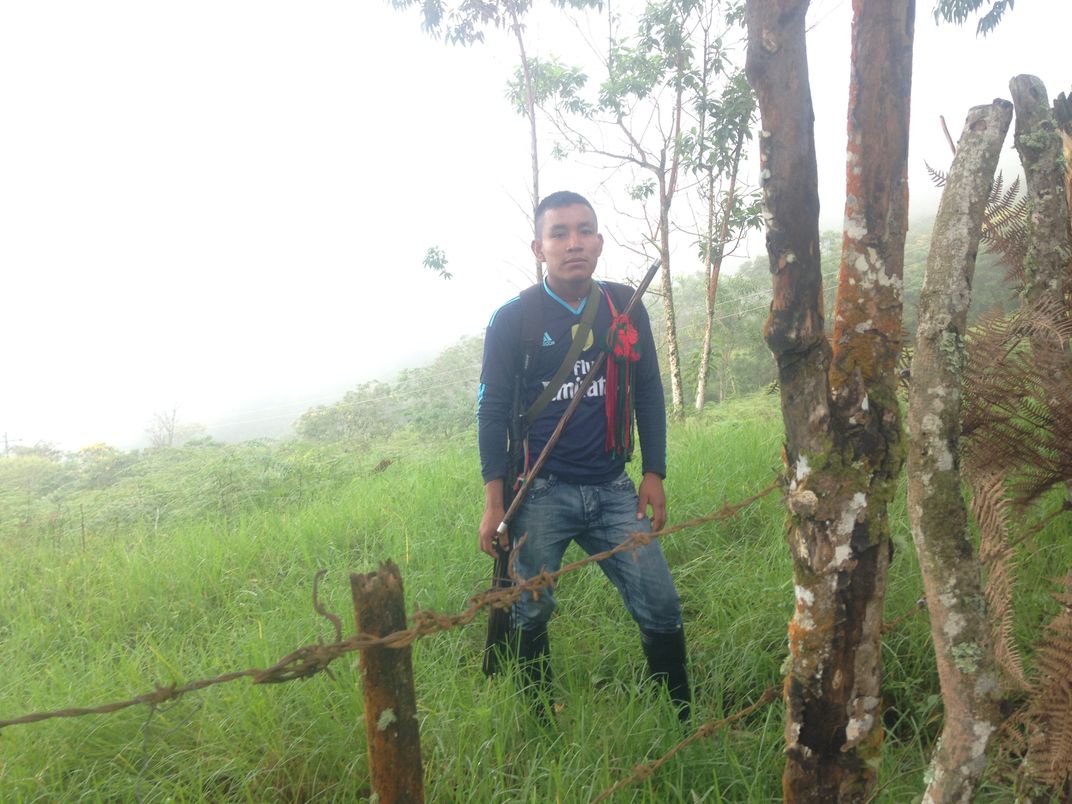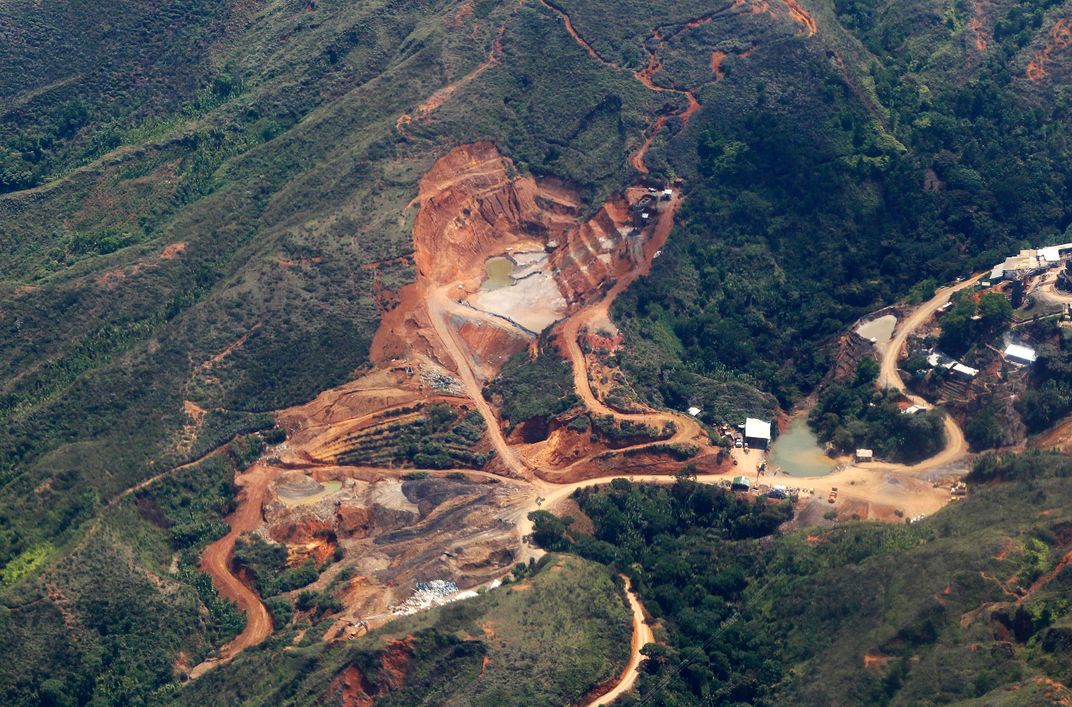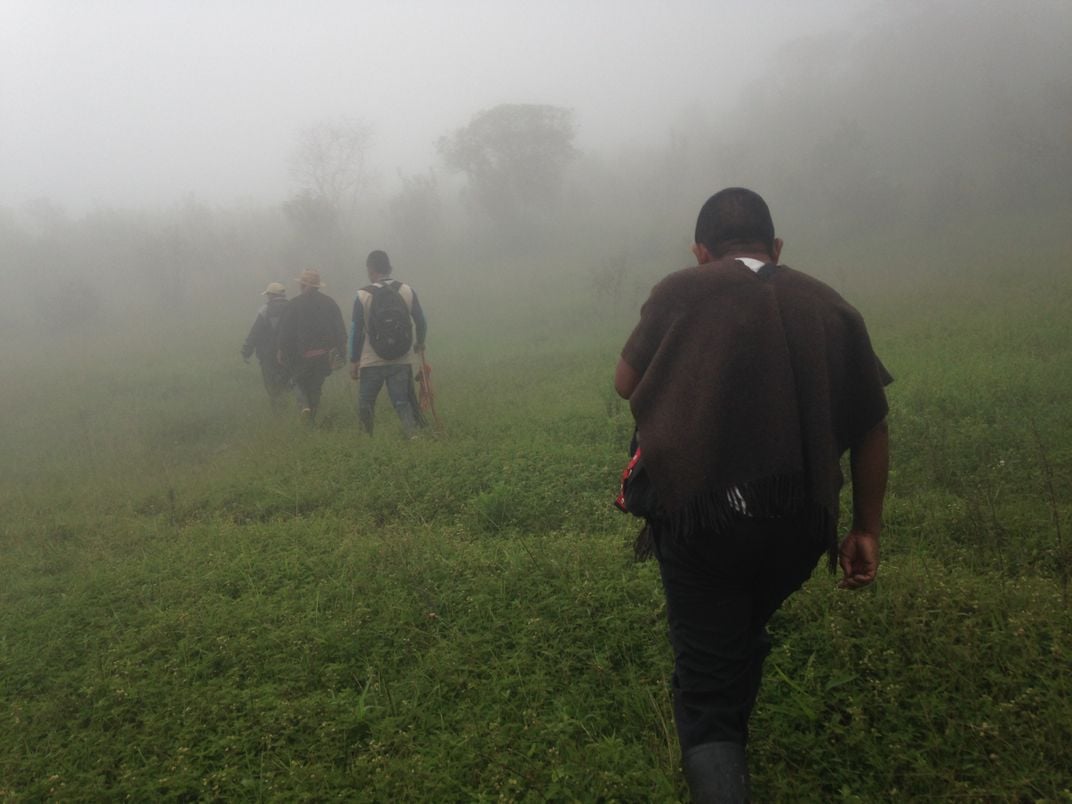How Colombia’s Failed Peace Treaty Could Wreak Havoc on Its Diversity-Rich Ecosystems
A potential influx of legal and illegal mining leaves the country’s megadiverse landscapes—and the communities who depend on them—in jeopardy
/https://tf-cmsv2-smithsonianmag-media.s3.amazonaws.com/filer/90/03/90033baf-b0cc-4c7d-8d46-881d8d2696f2/dy48aj.jpg)
Update, December 1, 2016: On Wednesday, Colombia’s government ratified a 310-page, revised peace agreement with the Revolutionary Armed Forces of Colombia or FARC. Last month, an earlier version of the peace agreement was narrowly rejected by voters in a national referendum. Read about the changes to initial agreement here.
Halfway up the mountain in Colombia's Las Canoas reserve, five indigenous men hold herbs in the palms of their hands. They circle them through the air, asking for permission to climb towards the summit. The greenery of the Andean rainforest flourishes around them.
One of the men, Wilson Valencia, carries a bastón, a wooden staff decorated with colored tassels that symbolizes his authority as a coordinator of the local indigenous guard. He and the others are part of the Nasa, a tribe that has lived in Colombia since long before the Spanish conquest. In 2001, after waves of violence against their villages, the Nasa formed the guard as a nonviolent police force to protect themselves from the threat of armed groups, drug traffickers and illegal miners.
During the 52 years of conflict in Colombia, armed groups have engaged in illegal drug cultivation and mining in these territories, often murdering indigenous and Afro-Colombians who stood up to them. But in 2012, Valencia tells me, the indigenous guard worked alongside peasant farmers and Afro-Colombian communities, employing a number of nonviolent methods to protest these groups' activities. Improbably, the guards managed to shut down illegal gold mines and end the violence that came with them in the area around Munchique, the name of this mountain.
Today, the fruits of their labor still stand: The entrances to the mines on the indigenous reserve at Las Canoas remain sealed, and the surrounding forest is thriving again after years of deforestation. The area's dense vegetation speaks to the country's natural assets: Colombia is a resource-rich, “megadiverse” country that lays claim to nearly 10 percent of the world’s biodiversity, according to the Convention on Biological Diversity. This 7,650-foot mountain serves as both the source of the Nasa's spiritual life and the water supply for the 7,000 people who live below.
But now, Valencia and others in his community fear that mining—both legal and illegal—could once again threaten Munchique.
Following the unexpected failure of Colombia's long-negotiated peace treaty, the provisions that likely would have protected indigenous groups from destructive environmental activities like mining face an uncertain future. As a result, the country's ecosystems and environmental defenders are at risk. Depending on the fate of the accord, this megadiverse country could see both legal and illegal mining continue unabated, or even get worse during the post-conflict period.
...
I visited Las Canoas in April, when the government and the Revolutionary Armed Forces of Colombia, the left-wing rebel group commonly known as the FARC, were nearing the end of a four-year peace negotiation. At that time, many Afro-Colombians and indigenous people—who had been caught between warring parties and had become some of the conflict’s primary victims—had misgivings about the accords. Even before negotiations began, Colombian President Juan Manuel Santos gave away a significant portion of the country’s terrain in mining concessions to multinational companies, according to the Washington Office on Latin America (WOLA).
“We don’t know a lot [about the accords] because the government sat down and talked with the guerrillas but not with us, the Nasa community,” Valencia said.
For ethnic communities, the Ethnic Chapter was a hard-won triumph. If implemented well, the deal would have restored land to those who had been displaced, and likely helped curb illegal mining in their territories by ending the conflict, itself a major driver of environmental destruction. After four years, it seemed as if Colombia’s ethnic communities were finally going to get the protection they wanted written into the deal.
Then everything fell apart.

On October 2, 2016, the peace deal was rejected by less than one percentage point by Colombian voters. That unexpected failure launched conservative former president Álvaro Uribe into a position of unprecedented political power. Uribe, who led the campaign against the deal, was seen as representing Colombians who had voted no.
Uribe quickly moved to consolidate his political capital, demanding a one-on-one meeting with President Santos and putting forth proposals of his own after criticizing the accords for years. Among those proposals was the suggestion that prior consultation—the cornerstone of ethnic land rights—be limited by the government so as not to “hinder the balanced development of the nation.” He also said that the state “should recognize the existence of large-scale commercial production, its importance within rural development and the national economy, and the state’s obligation to promote this.”
His statements put the protections that ethnic communities had fought so long for back in limbo.
Even before the peace deal, Colombia’s laws regarding the rights of ethnic communities who oppose large-scale economic projects in their territories were constantly under threat. Colombia’s constitution, ratified in 1991, gives wide-ranging rights to ethnic communities, including that of prior consent. So does the International Labour Organization’s Convention 169, of which Colombia is a signatory. However, multiple government administrations have attempted to limit communities’ rights to prior consent. In 2013, for instance, a decree passed that held that prior consent is only applicable to land for which communities hold legal title—which excludes many Afro-Colombian communities.
It gets trickier. Despite the constitutional guarantee, free trade agreements that Colombia has signed with Canada, the United States and the European Union undermine ethnic communities’ rights to prior consent. In international courts, these agreements are currently being used to challenge Colombia’s national laws. And to further complicate matters, while indigenous reserves and collectively held Afro-Colombian territories legally belong to the communities, anything beneath the topsoil—gold, minerals, oil—technically belongs to the government.
Amidst these complications, the Ethnic Chapter represented clear legal protections to indigenous communities. “We will protect the Ethnic Chapter with our very lives,” said Richard Moreno of the Afro-Colombian Peace Council (CONPA) at a recent conference hosted by the Washington Office on Latin America. And it’s not just the Ethnic Chapter that these communities worried about: It’s the fate of the deal itself, which would have ended a conflict that has been extremely destructive to both ethnic communities and the environment. Danilo Rueda, a human rights activist and co-director of the Inter-ecclesiastical Commission of Justice and Peace, warned at the conference that if the accords fail, it could usher in a “new long-term era of paramilitarism.”
Carlos Andrés Baquero, a lawyer with the Center for Law, Justice, and Society, a Colombian NGO devoted to promoting human rights and the rule of law, says that Uribe’s suggestion of restricting prior consent isn't necessarily new. A number of politicians, including Santos and Uribe, have been trying to do this for years. So far, the Constitutional Court has sided with ethnic communities. Baquero said that threats to prior consent were “like a ghost,” in that “you don’t know when they’re going to appear, but you know that it’s around . . . . Up to now what I can say is that I think the Ethnic Chapter will be safe.
“But that’s today,” he added. “We don’t know about tomorrow.”

Colombia's natural capital has often gone hand-in-hand with its entrenched conflict. That doesn't surprise Miguel Altieri, an agro-ecology professor at the University of California at Berkeley who has worked with small farmers in Colombia for 40 years. This is what is known in international development circles as the natural resource curse, or the "paradox of plenty." About half of all peace processes fail, and a 2001 study found that in places with valuable and readily available “spoils,” it was even more difficult to make peace.
For Altieri, the demand for Colombia’s natural resources has put the Colombian government at odds with itself. “On the one hand, you’re trying to promote peace, and at the same time have a development model that is highly destructive to environment and indigenous people,” he told me in a phone interview. In Colombia, land—and thus, wealth—is concentrated in the hands of the few. Consequently, land rights and ownership have always been central to the conflict—and natural resources like drugs and gold have helped to drive it.
In 2015, Colombia ranked as the third most dangerous place in the world for environmental defenders, according to a Global Witness report. Much of that is due to the conflict, which has allowed instability and violence to flourish in rural areas. "We get threatened, vilified and killed for standing up to the mining companies on our land and the paramilitaries that protect them," Michelle Campos, whose family was among those killed, told Global Witness.
Colombia’s violence has, inadvertently or not, often served the interests of multinational companies and big landowners, who have been able to grab land from peasant communities, indigenous, and Afro-Colombians. During the decades-long conflict, paramilitaries—in addition to the FARC—terrorized the Colombian population, carrying out forced displacement, massacres and sexual violence. They also assassinated labor leaders, leftists, indigenous people and Afro-Colombians, including those who protested illegal mining. The mining industry in particular has been infested with paramilitary and guerrilla violence. But not all forms of mining are created equal, says Gimena Sanchez.

Mining in Colombia can be loosely grouped into three categories. The first is ancestral mining, which is used by ethnic communities for the most part on a very small scale, by hand and without chemicals. These communities usually employ low-tech tools like trays, rods, hoes and in some cases, a motorized pump to drain water out of mineshafts dug with shovels, explains Carlos Heiler Mosquera, an Afro-Colombian leader from Colombia’s Chocó region. Mosquera serves on the Community Advisory Board, which regulates projects in the area that affect ecosystems.
Because communities only extract a little gold or other metal at once, and have been doing so for hundreds of years, ancestral mining is largely considered sustainable (though it too can cause small-scale pollution, especially when communities begin using cyanide and mercury, according to a report by Peace Brigades International.) Yet government efforts to crack down on illegal mining have sometimes lumped artisanal miners in with illegal medium- and large-scale miners, Sanchez told me.
The second is medium- and large-scale illegal mining, which is carried out principally by armed groups—including both left-wing rebels like the FARC and right-wing paramilitaries. Illegal mining, which uses heavy machinery including backhoes and dredgers, is often open pit, meaning that large areas of earth are usually blasted to get to the gold. This form of mining is carried out at such an intensive scale that in some cases accidents have occurred due to earth destabilization. One expert has estimated that as much as 88 percent of mining in Colombia is illegal.
Because it is not regulated, illegal mining is highly polluting, Sanchez told me, leaving waterways laced with the mercury and other chemicals used to separate the gold from the rock. “The environmental destruction wrought by these machines is starkly evident—desert-like riverside landscapes and pools of mercury and cyanide used in processing gold,” wrote Nadja Drost, a Bogotá-based journalist who has investigated gold mining and armed gangs in Colombia, in 2011. (In Peru, mercury produced by the illegal gold mining industry led to a large-scale health emergency, with more than 40 percent of villagers in the Madre de Dios region sickened by heavy metal poisoning.) In 2012, the FARC's profits from gold mining surpassed those of the drug trade.
While regulated, legal large-scale mining carried out by multinational companies also creates pollution. As with illegal mining, explosives are used to clear land away, rivers are sometimes diverted from their paths, and land is deforested to make room for equipment and infrastructure. Mining companies also create waste-water pits, which can be hazardous and noise from the explosives can scare away birds and other animals. Observers say that paramilitary violence is also used to clear the way for mining done by large corporations, both by displacing local communities and suppressing opposition to the mines.
For years, the Colombian government has denied the existence of paramilitary successor groups, calling them instead “criminal bands” and downplaying their influence and reach. The Havana peace accord changed that. It not only acknowledged the existence of paramilitary successor groups, but set up a commission whose objectives included dismantling those groups and recommending reforms “to eliminate any possibility that the State, its institutions, or its agents can create, support, or maintain relationships with” armed groups. The accords would have brought both private and state actors before the transitional justice tribunals, and held them to the same standard as the FARC—which likely would have helped to dismantle paramilitary groups.
Yet Uribe has spoken against this aspect of the accords and advocated instead that private and state actors only be prosecuted if they submit voluntarily to the tribunals. Uribe maintains that it is better for the accords to be renegotiated than to have succeeded at the voting booth. While he has focused much of his critique on the justice elements of the accords, he has taken aim at other aspects as well. “These accords kill private investment in Colombia,” he said in a televised interview on October 4. Uribe is seen by many as representing the interests of Colombian business leaders and landowners who profited from the conflict.
Despite the continued threat of armed groups and their fears about the post-conflict period, Afro-Colombians and indigenous people have not given up. Indigenous communities have begun organizing to demand that the accord be implemented in their areas, which overwhelmingly voted yes in the plebiscite.
Asdrúbal Plazas, the main indigenous advisor to the Ethnic Commission for Peace and Defense of Territorial Rights, sees the threat against the accord as political rather than legal, since the plebiscite vote was technically non-binding. Plaza told me that there would soon be a massive movement of Colombian ethnic communities demanding that the accord, including its protections against illegal mining and agribusiness, be put into place. On October 19th, thousands of people marched into the center of Bogotá to demand just that.
“If our territories said yes, if our ethnic territories are those that have most suffered the armed conflict . . . if we’re the ones who most want peace because we want to rest from this war, how can they deprive us of this right?” Plaza asked.
Reporting for this article was funded by an Adelante fellowship from the International Women’s Media Foundation.